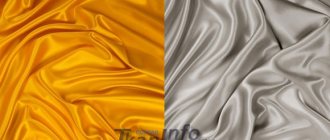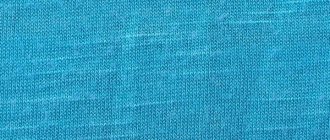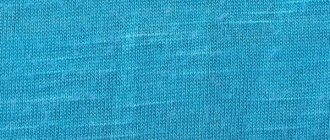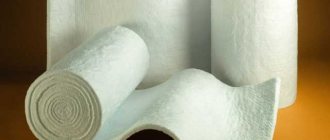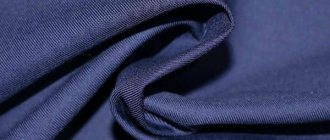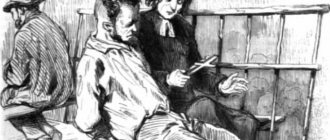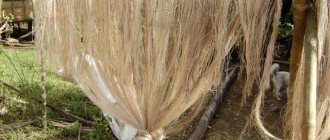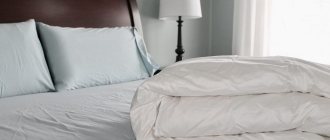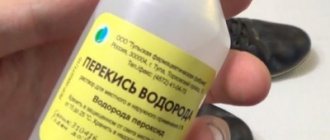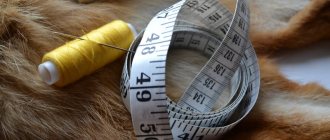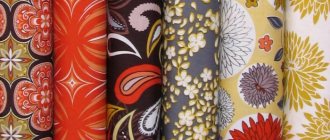People have long learned to make silk fabrics. But they were expensive, since the raw materials for their production were “supplied” only by the caterpillars of a tiny butterfly - the silkworm, which are distinguished by their extraordinary gluttony. Thirty times a day you have to serve them a “salad” of fresh leaves. However, this is not so scary: let them eat! The only bad thing is that caterpillars are very picky. The temperature in the room where they are bred drops slightly, and a “riot” begins: they slow down their growth. And one more thing: caterpillars cannot tolerate foreign odors and do not tolerate noise.
In a word, there is a lot of hassle with caterpillars, but their productivity is scanty: from one cocoon you can wind a thread only a kilometer long and weighing half a gram.
§ 12. Chemical fibers
You are already familiar with materials made from natural fibers - cotton, linen, wool, silk. But in the modern world, more and more fabrics are made from artificial fiber. Already in the 17th century. Englishman Robert Hooke suggested the possibility of producing artificial fiber. However, artificial fiber for making fabrics was produced industrially only at the end of the 19th century. In Russia, the first plant for the production of artificial silk was built in 1913 in the town of Mytishchi near Moscow.
In the wardrobe of a modern person it is rare to find something made from natural fiber. Today, almost all natural fabrics contain additives that improve their properties.
When purchasing fabrics, textiles and knitwear, you cannot rely only on their appearance
In order to properly care for an item, it is very important to know the raw material composition and properties of this material.
Chemical fiber production technology
Chemical textile fibers are produced by processing raw materials of different origins. On this basis they are divided into artificial and synthetic. The raw material for the production of artificial fibers is cellulose obtained from spruce wood and cotton waste. The raw materials for the production of synthetic fibers are gases - products of the processing of coal and oil.
The production of chemical fibers is divided into three stages:
- Obtaining a spinning solution. All chemical fibers, except mineral ones, are produced from viscous solutions or melts, which are called spinning. For example, artificial fibers are obtained from cellulose mass dissolved in alkali, and synthetic fibers are obtained by combining chemical reactions of various substances.
- Fiber forming. The viscous spinning solution is passed through dies - caps with tiny holes. The number of holes in the die ranges from 24 to 36 thousand. Streams of solution flowing out of the dies harden, forming solid thin threads. Next, the threads from one spinneret are combined into one common thread on spinning machines, pulled out and wound onto a bobbin.
- Fiber finishing. The resulting threads undergo washing, drying, twisting, and heat treatment (to fix the twist). Some fibers are bleached, dyed and treated with a soap solution to make them soft.
Control questions
1. What is the production technology of chemical textile fibers? 2. What are the raw materials for the production of chemical fibers?
What to do in this case?
Stop searching? Of course not. First of all, it was necessary to determine the chemical composition of mulberry leaves, from which the caterpillars produce threads that harden in the air, and then reproduce this process in the laboratory. The French chemist Audemar found that leaves consist mainly of cellulose, a substance made up of three types of atoms: carbon, hydrogen and oxygen. He then examined the silk thread. It turns out that this is a protein that contains the same three “building blocks” and nitrogen. The scientist breathed a sigh of relief: if you treat fiber with nitric acid, you will get silk.
The experiments were a success. But only in the middle of the nineteenth century did the British set up the first factory, in which, in fact, the “technology” of spinning threads with silkworms was reproduced on an industrial scale. Nitrocellulose dissolved in alcohol and ether was squeezed out through tiny holes into acidified water. Here the solvents were separated from the nitrocellulose, and it was turned into a thin thread.
Soon, artificial silk products appeared on store shelves. However, few dared to wear them: blouses and dresses burned like gunpowder!
Production
Viscose fiber began to be produced at the end of the 19th century, modern production has undergone some changes, however, the basics have remained unchanged. Viscose is made from wood pulp that has been treated with chemicals. There are several stages of production:
- Preparation of cellulose. To begin with, the wood is dried, cut into small chips and boiled in an alkaline solution. Then squeezed and crushed.
- Obtaining a spinning solution. The mass goes through the stages of treatment with carbon disulfide and maturation, during which it becomes viscous and loses resistance to the action of acid solutions. At the same time, dyes or matting elements are added to the mass.
- Molding of thread using the wet method. The resulting viscose mass is fed into a spinning machine, where it is pressed through plates with tiny holes (dies) and deposited in a bath with an acid solution, streams of material harden, and viscose threads are obtained.
- Finishing and drying. The threads are washed, bleached, treated with soapy water to make them soft, dried and twisted.
Comparison
The main difference between artificial fibers and synthetic ones is that natural substances are used as raw materials for the production of the former. The production of the latter involves the use of low molecular weight inorganic substances, which are rarely found in their natural form, as well as the production of compounds that are practically not formed in nature.
It is worth noting that in any case, artificial and synthetic fibers are usually separated from natural ones when classifying certain goods, since in their finished form neither the first nor the second have direct natural analogues that could be used as third ones.
But artificial fabrics in general are considered to a certain extent more natural than synthetic ones, since, as we noted above, substances present in nature are used as raw materials for their production.
The initial natural raw material for artificial fabric - for example, cellulose - is, one way or another, the basis for the formation of the corresponding product. For example, cellulose treated with sodium hydroxide followed by polymerization turns into viscose.
In turn, the chemical composition of synthetic fabrics can be significantly more complex. From the components of the raw materials used for their production, it is sometimes difficult to identify the main one.
Having determined what the difference is between artificial and synthetic fibers, we will reflect the conclusions in a small table.
Clarifications are needed here
In everyday life, fibers created by chemical means are sometimes called artificial or synthetic. In reality, they are not the same thing. Here's what you need to remember: If the resulting fibers consist of the same molecules that were in the original substance, then they are called artificial. The molecules of synthetic threads are built anew from simpler substances. The raw materials for artificial fibers are natural materials consisting of giant molecules - fiber, proteins, and for synthetic ones - chemical products consisting of dwarf molecules - oil, coal, gases.
So, cellulose fibers, which seemed to have revealed their secrets long ago, have acquired new properties thanks to the efforts of scientists. You may know that ion exchangers are high-molecular compounds that perfectly capture various substances from solutions, usually prepared in the form of sand. Scientists have imparted the properties of ion exchange resins to ordinary cellulose threads. They are now used to produce canvas that is needed by many industries.
What can you say about fabric that kills bacteria around itself?
Don't be surprised, there is one. It is used to cover the walls of operating rooms and workshops in pharmaceutical factories, where the air must always be sterile. Bags for medical instruments can be made from this fabric. Without wasting a minute on processing them, the doctor can perform operations in the most seemingly inappropriate conditions. Bandages made from such fabric are able to destroy bacteria even on untreated wounds. It is possible that “death to sores” or “heroic health” costumes will go on sale. Natural silk at a low price
Polyvinyl alcohol fibers
They have an excellent set of consumer characteristics: durable, high abrasion resistance, high heat resistance and light resistance, as well as increased hygroscopicity (unlike all other synthetic fibers). Modification of such fibers makes it possible to obtain fibers with certain properties: fire-resistant, bactericidal, ion-exchange, etc. Vinol is used in the production of fabrics for underwear and clothing, and in a mixture with cotton and viscose - for the production of hosiery. Mtilan has antimicrobial properties and is widely used in medicine as threads for surgical sutures.
Other trade names: vinylon, kuralon, vinalon, etc.
| ALSO ON THE TOPIC: | YOU MAY BE INTERESTED IN: |
Man-made cellulose fibers
The first man-made fibers to be developed and manufactured used naturally occurring polymers, more specifically cellulose, which is a raw material available in large quantities in the plant kingdom.
Cellulose is a natural polymer that makes up the living cells of all vegetation. It is the material at the center of the carbon cycle and the most abundant and renewable biopolymer on the planet.
Cotton sheets and wood pulp, rayon, copper-ammonia silk, cellulose acetate (recycled and triacetate), polynose, high wet modulus (HVM) fiber.
- Cellulose is one of many polymers found in nature.
- Wood, paper and cotton contain cellulose. Cellulose is an excellent fiber.
- Cellulose is made up of repeating units of monomeric glucose.
- The three types of regenerated cellulose fibers are rayon, acetate and triacetate, which are derived from the cell walls of short cotton fibers called linters.
- Paper, for example, is almost pure cellulose
What are synthetic fibers?
Synthetic fibers are usually classified as fibers that are made using low molecular weight substances, often of inorganic origin. These are compounds of carbon, hydrogen, nitrogen. Their processing can be carried out by polymerization or polycondensation.
When it comes to polymers, they are produced from products obtained from the processing of oil, gas or coal (for example, benzene, acetylene or ammonia) or formed as by-products of various chemical industries.
In the process of processing raw materials, a manufacturer of synthetic fibers can, at its discretion, regulate their chemical composition and thus establish the desired consumer properties of the corresponding materials and their structure.
How to use
Due to the advantages of viscose fiber, its use is very wide, both in pure form and in combination with other fibers: it is used to produce textile fabrics for clothing, home textiles, cleaning materials (non-woven viscose base), as well as a wide range of technical products: packaging film, sponges, etc.
Modal
It is made from wood cellulose (100%), has the properties of cotton, and is superior to it in some respects: 1.5 times more hygroscopic, has increased strength and wear resistance.
In combination with cotton, modal is used for sewing bed linen and clothing.
Tencel
Began production in 1992 in the USA. It entered the market under different names, which were assigned to it by the companies that owned the brands - Lyocell, Tencel, Newcel.
Made from cellulose extracted from eucalyptus trees. The result is a very soft and silky material, similar in characteristics to cotton. It is also characterized by increased strength, hygroscopicity and breathability, but is subject to deformation.
Tencel is also used to produce clothing, linen and home textiles.
Acetate
To produce this type of fabric, it is not cellulose itself that is used, but its waste, called cellulose acetate.
In terms of external qualities, the material resembles silk - thin, slightly shiny. Acetate is resistant to deformation, dries quickly, and wrinkles little.
Disadvantages include poor hygroscopicity - it almost does not absorb moisture, as well as instability to temperatures and acetone - it begins to melt at a temperature of 200 degrees, and dissolves when exposed to acetone.
Used for lining fabric.
Read about: supplex is a fabric that is amazing in its elasticity. cupra
Cupra is usually used to make elegant clothing.
The pleasant joy of acetate silk
The demand for acetate silk has been fueled by one interesting feature: it perfectly transmits ultraviolet rays. If you make a dress out of it, you can sunbathe in it on the beach without undressing. The method of producing such silk is very simple. The raw material for it is the same cellulose dissolved in alcohol and acetone. The resulting solution, having passed the dies, enters a box through which hot air is blown. The alcohol and acetone immediately evaporate, and the resulting thread is wound onto spools. Acetate silk has amazing strength. A rope with a cross section of one centimeter, twisted from it, can withstand a ten-ton load!
Acetate
A derivative fiber in which the fiber-forming substance is cellulose acetate. Acetate is produced from cellulose by the reaction of refining wood pulp with acetic acid and acetic anhydride in the presence of sulfuric acid.
Characteristics of acetate fiber:
- Luxurious feel and look
- Wide range of colors and glosses
- Excellent drape and softness
- Relatively fast drying
- Resistant to shrinkage, moths and powdery mildew
Special dyes have been developed for acetate because it does not accept dyes commonly used on cotton and rayon.
Acetate fibers are manufactured fibers in which the fiber-forming substance is cellulose acetate. The cellulose ethers triacetate and acetate are formed by the acetylation of cotton linters or wood cellulose using acetic anhydride and an acid catalyst in acetic acid.
Acetate and triacetate fibers are very similar in appearance to permanent tenacity rayon. Elements and triacetates are moderately stiff fibers and have good flexural and deformation elasticity, especially after heat treatment.
The abrasion resistance of acetate and triacetate is poor, and these fibers cannot be used in applications requiring high abrasion and wear resistance; however, the abrasion resistance of these fibers is excellent. Although acetate and triacetate are moderately absorbent, their absorption cannot match that of pure cellulose fibers. Acetate fabrics feel slightly softer and more flexible than triacetate. The fabrics of both fibers have excellent drape characteristics. Acetate and triacetate fabrics have a pleasing appearance and a high degree of shine, but the sheen of these fabrics can be modified by adding a matting agent.
Both acetate and triacetate are susceptible to attack by a number of household chemicals. Acetate and triacetate are exposed to strong acids and bases and oxidizing bleaches. Acetate has only a slight resistance to sunlight, while the sun resistance of triacetate is higher. Both fibers have good heat resistance below their melting points.
Acetate and triacetate cannot be dyed with the dyes used for cellulose fibers. These fibers can be satisfactorily dyed with disperse dyes at moderate to high temperatures to produce crisp, vibrant shades. Acetate and triacetate dry quickly and can be dry cleaned.
2020 textiletrend.ru
Washing artificial fabrics
To prevent artificial fabrics from wearing out for a long time and losing their shape and presentable appearance, you should remember and apply simple care rules. So, washing artificial fabrics should be done on a delicate cycle, the recommended temperature should be no more than 30 degrees. This way you will definitely not harm products made from these fabrics. Items made from these fabrics must be dried in natural conditions, avoid direct sunlight and artificial heat sources. As a rule, ironing of such fabric is not required, but if necessary, set the iron to the delicate setting.
Thus, good artificial threads are a good investment, things made from such fabrics look great in absolutely any weather, they are very practical, indispensable in everyday life, a large assortment and choice of colors allows you to successfully combine color tones and choose the best solutions for popular clothing styles. Try to properly care for these types of fabrics and you will enjoy their use.
Viscose
Originally, the word "viscose" was applied to any fiber made from cellulose and therefore containing cellulose acetate fibers. However, the definition of viscose was described in 1951 and now includes textile fibers and fibers consisting of regenerated cellulose, excluding acetate.
Read about: what kind of hemp fabric is this: features and description.
- Viscose is a regenerated cellulose fiber.
- This is the first man-made fiber.
- It has a jagged circular shape with a smooth surface.
- When wet, viscose loses 30-50% of its strength.
- Viscose is formed from natural polymers and is therefore not a synthetic fiber, but a man-made regenerated cellulose fiber.
- The fiber is sold as rayon.
- There are two main types of viscose fiber, namely viscose and copper-ammonia.
Is there an alternative?
Is it possible to make fabric from some other raw material? This question is far from idle. Life itself set it up. Many people puzzled over it. It was studied more than two hundred and fifty years ago by the English astronomer and mathematician Robert Hooke. The famous French scientist Rene Antoine Reaumur tried to solve this problem, giving the world a thermometer. He set out to get silk... from a spider's web. With great difficulty, he managed to collect a handful of threads woven by spiders from dusty attics, and from them made a piece of durable and beautiful fabric, similar to smoky silk with a golden tint. But this method had one very significant flaw: the spiders of the whole world could not provide even a small weaving factory with raw materials. So there was no question of introducing it into production.
